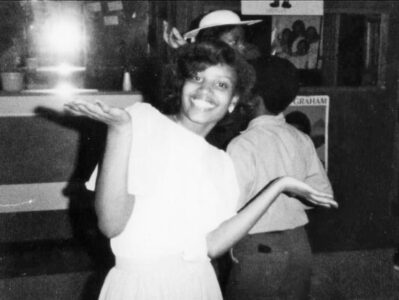In Arizona, an African American doctor creates street art to heal the Navajo Nation. In São Paulo, a graffiti artist documents the lives of the homeless and working-class. In New Orleans and Chicago, an artist creates a space for people to share dreams. There’s plenty of cool street art out there, but these three artists use walls, thought, and skill to change lives.

Jetsonorama began wheatpasting large-scale photo-collages in 2009, reports Sarah Gilman for High Country News, after experimenting with photography and small-scale wheatpasting for the two-plus decades he’d served as a physician on a Navajo reservation. His work evolved and last September, as part of 350.org’s EARTH initiative to bring awareness to climate change, the artist wheatpasted giant images of a baby’s face looking up at a cloud-like lump of coal. Writes the artist on his blog:
“everyone i talked with was raised on the reservation. they all identified coal as a cheap source of fuel, especially for the elders. […] everyone in my small sample identified respiratory problems associated with burning coal in the home. everyone acknowledged that the coal mined on the reservation is used to generate energy off the reservation for surrounding megalopolises such as denver, phoenix, albuquerque, las vegas and l.a. they found this arrangement to be problematic.”
Jetsonorama’s work seeks to heal beyond coal and its effects on individual bodies. Each of his pieces functions as a conversation-starter, creating both dialogue and a source of local pride.

Amidst the rubble of São Paulo Brazil, Bruno Dias celebrates everyday locals, be they homeless, prostitutes, or street vendors. For art nouveau‘s Kendrick Daye, Dias’ art “expresses the relationship between physical space and the people of the country.” When the audience begins to recognize a spray-painted image as the homeless man nearby or a face on the wall as a street vendor, we can’t help but wonder what became of those who are not in the photographs near their portraits. In this sense, Dias has discovered a way to document the everyday fates of the oft-overlooked. The artist does not pretend that his portraits begin to solve social quandaries such as homelessness and prostitution, but he does commemorate those most affected by poverty and social struggle.

In post-Katrina New Orleans, artist Candy Chang brought focus back to goals and desires by turning one wall of a decrepit building into a chalkboard. The upper left corner reads “Before I die…” and below it are nearly one hundred places for passers-by to fill in the blank. “Before I die I want to ______________.” Answers range from the daunting, “SEE EQUALITY” to the playful, “Swim w/out holding my nose!” For a city burdened with the task of rebuilding as the rest of the nation scrutinizes, what better to focus on than hopes and dreams for individuals, community, and society?
“Before I die…” is not relevant only to New Orleans, however. Because the work re-centers viewers and creates a forum for local conversation ? two things sorely lacking in our plugged-in global network ? it seems it would be relevant almost anywhere. Earlier this month, the piece was installed in Chicago. The space (pictured above) was quickly filled beyond the sanctioned blank lines, reports Christopher Jobson of Colossal. And since Chang created a toolkit allowing installation anywhere, “Before I die…” has popped up in countries such as Mexico, Kazakhstan, and Portugal.






